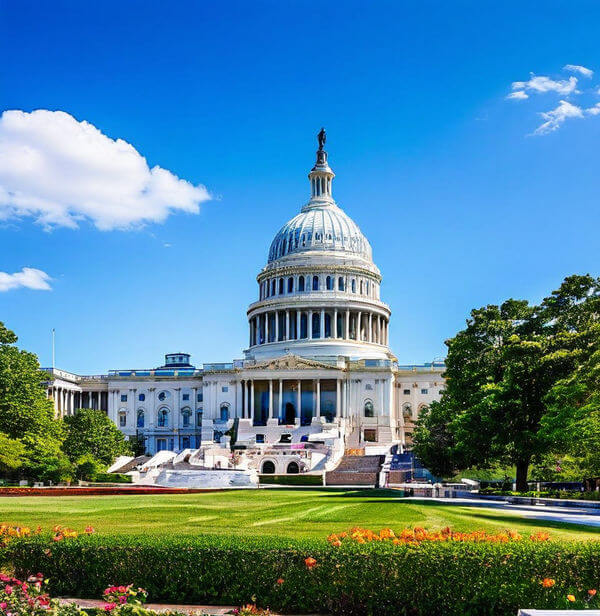
When applying for a marriage green card, a K-1 fiancé visa, or U.S. citizenship, you must complete specific forms required by the U.S. government. Each type of application involves different costs and processing times, which can vary depending on the visa category. Traditionally, obtaining a green card through a fiancé visa was quicker but costlier compared to a CR-1 spousal visa. However, recent trends show that the processing times for both visa types have aligned. For couples who opt to marry outside the U.S., this alignment could offer a cost advantage. Conversely, for those planning to marry within the U.S., understanding the total expenses associated with obtaining a green card is crucial.
Notable USCIS Fee Increases for 2024
On January 31, 2024, USCIS announced a significant revision of its fee structure, marking the first major changes since 2016. This new fee structure, effective from April 1, 2024, includes substantial increases in filing fees across a wide range of immigration applications, affecting both family and employment visa categories. The fee changes follow USCIS’s proposed adjustments last year and will impact many immigrants and businesses relying on these visa processes.
These updates in processing times and costs, especially with the impending fee increases, are vital for applicants to consider as they plan their immigration journeys. Keeping informed about these changes can help manage expectations and budget appropriately for the immigration process.
Starting April 1, 2024, USCIS will implement a significant increase in fees for various immigration applications, reflecting the first substantial change in fee structure since 2016. Below are details regarding the expected fee changes for key immigration forms:
- Naturalization (Citizenship) Application (Form N-400) will see an increase from $640 to $760, which is a 19% rise amounting to an additional $120.
- K-1 Fiancé Visa (Form I-129F) fees will go up by 26%, from $535 to $675, an increase of $140.
- CR-1 Spousal Visa (Form I-130) will also experience a 26% fee increase, rising by $140 from $535 to $675.
- Removal of Conditions (Form I-751) will cost $750, up from $680, marking a 10% increase of $70.
- Employment Authorization Document (EAD, Form I-765), previously $410, will now be $520, reflecting a 27% hike of $110.
- Advance Parole (Form I-131) is set to increase from $575 to $630, up by $55.
- Adjustment of Status Application (Form I-485) for individuals over 14 will rise from $1225 to $1440, an 18% increase of $215.
- Adjustment of Status for Children Under 14 (Form I-485) will see a fee of $950, up from $750, a 27% increase of $200.
- Marriage Green Card package, which includes relative petition, EAD, and AP (Forms I-485, I-130, I-765, I-131), will substantially increase from $1760 to $3005, a 71% rise amounting to $1245.
Additionally, Form I-765 will now cost $260 when filed with a marriage green card application, and Form I-131 will be priced at $630.
These adjustments in fees are part of USCIS's biennial review requirement, which had not seen changes since 2016. The agency has identified that the current fees do not adequately support its services or address the application backlog. The new fee structure is designed to increase USCIS's revenue by an estimated $1.9 billion annually, helping improve service delivery and reduce delays. USCIS has incorporated public feedback from a comment period last year and continues to offer fee waivers for eligible, low-income applicants to ensure fairness based on the applicant’s ability to pay.
Overview of Green Card Application Costs and Fees (2024)
Here’s a detailed look at the costs associated with various green card-related forms, organized alphabetically by government form as of April 2024:
- Form DS-260 (Online Immigrant Visa Application): Used when applying for a green card from outside the United States through consular processing. The filing fee for this form is $325, and it must be filed by the relative seeking the green card.
- Form DS-261 (Online Choice of Address and Agent): This form, which has no filing fee, is used to notify the State Department of your contact information when applying for a green card through consular processing.
- Form I-129F (Petition for Alien Fiancé(e)): Filed by U.S. citizens or green card holders to bring their fiancé(e) (and their children, if applicable) to the U.S. to marry and apply for a green card. The filing fee is $675.
- Form I-130 (Family Sponsorship Petition): This form is used to establish a valid family relationship between a U.S. citizen or green card holder and their relative who is seeking a green card. The filing fee is $675.
- Form I-130A (Supplemental Information Form): Supplements Form I-130 with detailed information about the spouse seeking a green card and has no filing fee.
- Form I-131 (Application for Travel Document: Advance Parole): Allows green card applicants to travel internationally while their application is pending. The filing fee is $630.
- Form I-485 (Green Card Application): Used for applying for a green card within the United States through the Adjustment of Status process. The filing fee is $1440, or $950 for applicants under 14 years old.
- Form I-693 (Report of Medical Examination and Vaccination Record): Required to document medical examination results for green card applicants and has no filing fee.
- Form I-751 (Petition to Remove Conditions on Residence): Used by conditional green card holders to upgrade to a 10-year permanent green card. The filing fee is $750.
- Form I-765 (Application for Employment Authorization Document): Requests permission for lawful work in the U.S. while the green card application is pending. The fee is $260 if filed with Form I-485; otherwise, it is $520.
- Form I-864 (Financial Support Form) and Form I-864A (Contract Between Sponsor and Household Member): These forms demonstrate that the sponsoring relative or joint sponsor meets the income requirements to support the green card applicant. Both forms have no filing fee.
- Form I-90 (Application to Replace Green Card): Applied when renewing or replacing an expired, soon-to-expire, lost, stolen, or damaged green card. The filing fee is $465.
Additional USCIS Forms and Their Fees
When navigating through various immigration processes, there are additional forms you might need to submit alongside your main application. Here’s a rundown of these forms, their purposes, and associated costs:
- Form AR-11 (Change of Address Form): Used to inform USCIS of any changes to your address. This form is essential for anyone who has filed other forms with USCIS to ensure all correspondence reaches you. Filing Fee: $0.
- Form G-1145 (Request for Electronic Notification): Allows applicants to receive email or text notifications once USCIS accepts their forms. This form should be submitted to a USCIS lockbox. Filing Fee: $0.
- Form G-1450 (Credit Card Payment Authorization Form): Enables the payment of filing fees via credit card. This form is used when submitting forms to a USCIS lockbox. Filing Fee: $0.
- Form I-865 (Sponsor’s Notice of Change of Address): Required for U.S. citizens or green card holders who are sponsoring a relative for a green card and need to update USCIS about a change of address. Filing Fee: $0.
- Form I-942 (Request for Reduced Fee): Provides an opportunity for green card holders applying for U.S. citizenship to request a reduction in the filing fee if their household income is between 150% and 200% of the Federal Poverty Guidelines. Filing Fee: $0.
- Form I-912 (Request for Fee Waiver): Allows applicants to request a waiver for filing fees due to low income (as defined by the Federal Poverty Guidelines), financial hardship, or receipt of public benefits. This form is applicable depending on the other forms you are filing. Filing Fee: $0.
Understanding the purpose of each USCIS form and knowing their fees can significantly streamline your immigration process. These forms are designed to ensure that your application is processed smoothly and that you maintain compliance with USCIS requirements. Most of these supplementary forms are free, making them accessible to applicants under various circumstances, from financial hardship to simply updating personal information.

